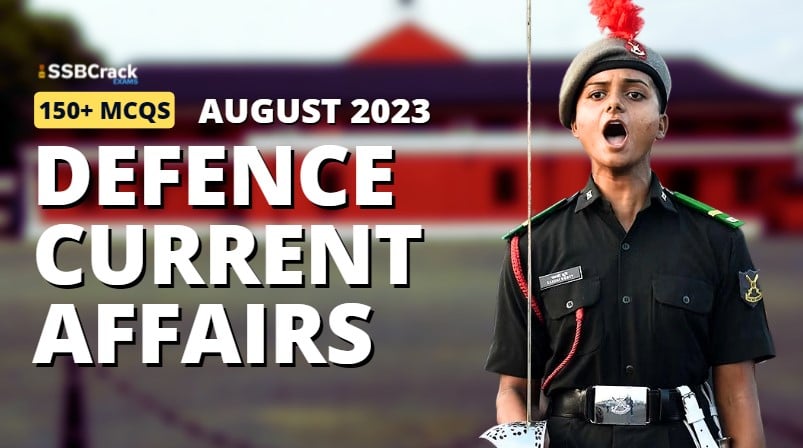Defence Current Affairs MCQs: Welcome to the Defence Current Affairs MCQs for August 2023. Staying updated on current developments in the field of defense is crucial for aspirants preparing for a variety of competitive exams such as NDA, CDS, AFCAT, and SSB Interview. These MCQs also provide valuable insights for other Indian competitive examinations like UPSC, Banking, Railways, and SSC. Our comprehensive set of multiple-choice questions will test your knowledge on the latest national and international defense news, advancements, and policies, helping you stay one step ahead in your preparation. So, gear up and test your readiness to take on the challenges of your upcoming exams.
Defence Current Affairs MCQs August 2023
1. What is the INS Visakhapatnam’s primary role as a Visakhapatnam-class stealth guided-missile destroyer?
A. Anti-submarine warfare
B. Anti-aircraft warfare
C. Amphibious assault
D. Mine countermeasures
Answer: B. Anti-aircraft warfare
Explanation: The INS Visakhapatnam, as a Visakhapatnam-class destroyer, is primarily designed for anti-aircraft warfare, making it capable of defending against aerial threats.
2. Which Indian city is the INS Visakhapatnam named after?
A. New Delhi
B. Mumbai
C. Visakhapatnam
D. Chennai
Answer: C. Visakhapatnam
Explanation: The INS Visakhapatnam derives its name from the historic city of Visakhapatnam, located on the east coast of Andhra Pradesh, often referred to as the ‘City of Destiny.’
3. What is the maximum speed that the INS Visakhapatnam can achieve?
A. 20 knots
B. 25 knots
C. 30 knots
D. 35 knots
Answer: C. 30 knots
Explanation: The INS Visakhapatnam is capable of achieving speeds in excess of 30 knots, making it a fast and agile naval vessel.
4. How is the reduced Radar Cross Section (RCS) of the INS Visakhapatnam achieved?
A. Through advanced radar technology
B. Through its size and bulkiness
C. Through efficient shaping of the hull and other design features
D. Through a specially designed paint coating
Answer: C. Through efficient shaping of the hull and other design features
Explanation: The INS Visakhapatnam achieves its reduced Radar Cross Section (RCS) through the efficient shaping of the hull, a full beam superstructure design, plated masts, and the use of radar-transparent materials on exposed decks.
5. What is the complement of personnel aboard the INS Visakhapatnam?
A. Approximately 200 personnel
B. Approximately 250 personnel
C. Approximately 315 personnel
D. Approximately 400 personnel
Answer: C. Approximately 315 personnel
Explanation: The INS Visakhapatnam has a total complement of about 315 personnel who serve aboard the vessel.
6. What is the primary objective of the Yudh Abhyas joint military exercise between India and the USA?
A. Counterterrorism operations
B. Promote cooperation and training between the two armies
C. Cybersecurity drills
D. Naval warfare exercises
Answer: B. Promote cooperation and training between the two armies
Explanation: The primary goal of the Yudh Abhyas exercise is to foster cooperation and training between the Indian and US armies through joint exercises, cultural exchanges, and building joint operating skills.
7. When did the Yudh Abhyas joint military exercise between India and the USA commence?
A. 2000
B. 2004
C. 2010
D. 2015
Answer: B. 2004
Explanation: Yudh Abhyas has been conducted annually since 2004, making it an ongoing joint exercise between the two countries.
8. Which chapter of the UN Mandate does Yudh Abhyas 2023 focus on for the deployment of an integrated battle group?
A. Chapter I
B. Chapter V
C. Chapter VII
D. Chapter IX
Answer: C. Chapter VII
Explanation: Yudh Abhyas 2023 concentrates on the employment of an integrated battle group under Chapter VII of the UN Mandate, which encompasses peacekeeping and peace enforcement operations.
9. What aspect of military operations is emphasized during Yudh Abhyas joint exercises?
A. Amphibious warfare
B. Humanitarian Assistance and Disaster Relief (HADR) operations
C. Cyber warfare
D. Guerrilla tactics
Answer: B. Humanitarian Assistance and Disaster Relief (HADR) operations
Explanation: Yudh Abhyas exercises place a significant focus on Humanitarian Assistance and Disaster Relief (HADR) operations, involving swift and coordinated relief efforts following natural disasters.
10. In what type of conditions will the coalition-integrated battle group be deployed during Yudh Abhyas exercises?
A. Desert conditions
B. Mountainous and extreme climatic conditions
C. Urban warfare scenarios
D. Tropical rainforest environments
Answer: B. Mountainous and extreme climatic conditions
Explanation: The Yudh Abhyas exercises will see the deployment of the coalition-integrated battle group in challenging mountainous and extreme climatic conditions, where they will demonstrate their operational capabilities.
Download Full : Defence Current Affairs August 2023 eBook [2722+ Questions Included]














